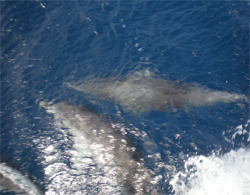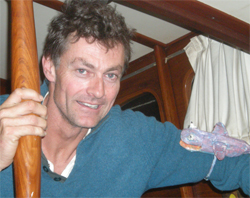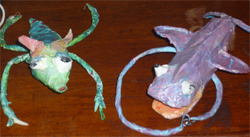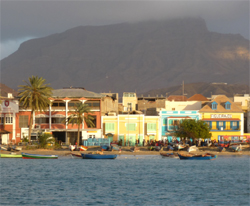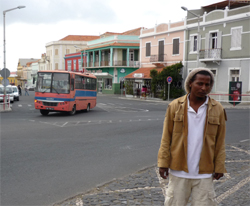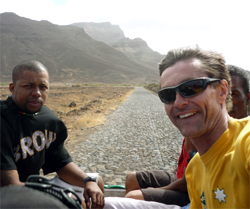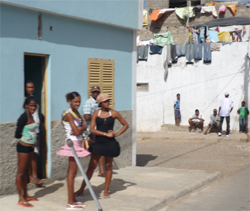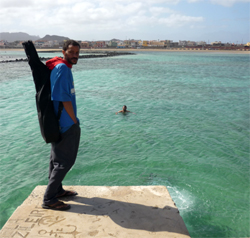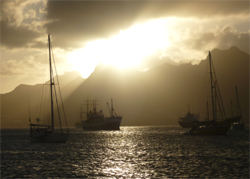Weatherly Sailing Adventures
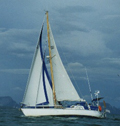
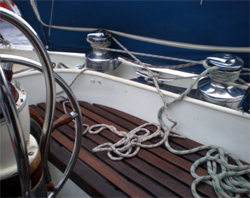
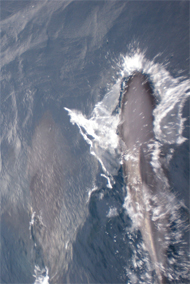
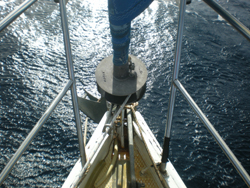
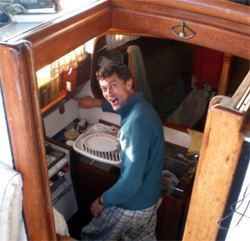
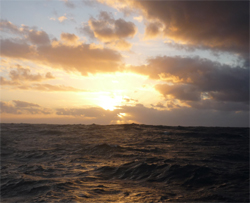
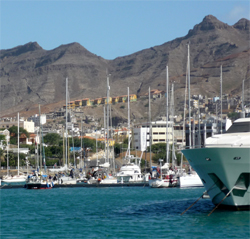
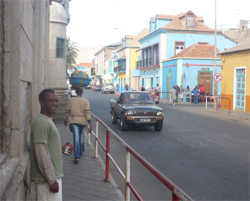

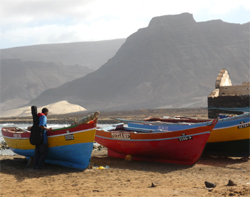
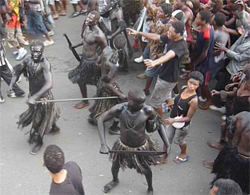
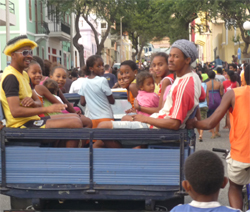
It is just over 800 nautical miles from the Canary islands (Gomera) to the Cape Verde islands
(San Vicente).
[Click here to see the map].
I estimated it would us take 8 days, at a conservative 100miles per day, as
Weatherly is a heavy displacement boat of 17tonnes, and slower than modern fibreglass yachts.
In this region, the Atlantic trade winds
commence, and we logged exhilerating boat speeds of up to 10.4knots, when surfing down waves.
The power of the wind is really felt in these conditions, when the boat hums and waves spray from
the bow. We always sail the boat to have control, so the mainsail was shortened to the 3rd reef, and
genoa furled in or let out, to maintain stability and comfort. But the wind was generally consistent
for us, at between 25 to 35 knots, and from an almost ideal direction of North to North East
(behind), with only slight changes over each day.
The windvane and autopilot combination worked well, and there was little need to hand steer in the crossing. Sometimes I took the helm just for the fun of directly feeling the boat's motion through the sea. I alternated watchkeeping duties every four hours with my crew, Chris. Sometimes we tried six hour watches, but four hours seemed to work better for us. The bells from my ship's clock chime twice for each hour (and one extra bell on the half hours), up till 4 oclock, 8 oclock and 12 oclock. So it's possible to know what time it is by counting the bells. Usually we just slept through until the other woke us for the changeover, being greeted with a coffee and sometimes music to wake up to.
The crossing took us just six days, and we averaged 5.5knots overall.
I was missing Tes, especially the first few days, and time seemed to drag so slowly. Could I handle the separation from her for another five weeks, before reuniting in the Caribbean? Then I was reminded of a serenity prayer in my mothers kitchen when I was a kid...
'Grant me the Serenity
To Accept the things I cannot change
The Courage to Change the things I can
And the Wisdom to know the Difference.'
There was nothing I could do now to change the fact Tes was not with me, so I put my mind to enjoying what I had in the present moment, and it helped me through the feeling of separation from mi amor.
We spotted large pods of dolphins, some leaping high out of the water, appearing to be showing off. They seem so effortless and graceful, and made us feel happy watching them play around the boat.
Tes gave me her two funny puppet animals (from her car), which she'd created from paper machieh - a whale, and a green 'creature'. They seem to have personality and humour. I amused myself and Cris one day by strapping the whale to my arm and in mock pretence it was Tes herself, showed amorous affection toward it. We were laughing and Chris took some funny pictures of the puppet show.
We had some interesting philosophical discussions on the way, and differences of beliefs too. He has read many interesting books on spirituality and Law of Attraction (such as 'Conversation with God', 'Seat of the Soul' and 'Hologram Universe'). He claimed reincarnation is true and has been proven. Heated points of view were expressed over this, and one day he captured me on camera asking me again 'Do you believe in reincarnation ?' I almost yelled back but with a huge smile 'NO, of course not !' and the video clip made me laugh about these conversations.
The time passed, and after an enjoyable sailing passage (and a ripped mainsail), we arrived in Mindelo, in the Cape Verde islands. It has high rocky mountains, but is not so green as the name suggests. (The name is derived from the cape across the sea, in Africa, so I doubt it would be green either).
We had gusts up to 50 knots at the entrance to the port. Luckily I'd furled the large genoa sail a few minutes earlier or it might have been shredded. We motored in, and finding a good location and I set the two main anchors against very strong winds. Then we celebrated our arrival with a beer.
Mindelo is a charming port town with clashing pastel coloured buildings, doors and windows, and in Portuguese architecture. The people are African looking, but speak Portuguese and Creoul. They are friendly and helpful, though often quite poor.
They have a funny handshake between men in the Cape Verde islands. With a closed fist you touch the others knuckles and then thump your chest. I adopted it, with a broad smile, as it seemed a fun and cool custom ('yo man').
Tes had given me her drums to stow and practice with, and I sometimes played them in the cockpit or inside Weatherly. I befriended many locals in Mindelo. One guy I met had a rastafarian haircut and I thought he might be muscally inclined. Ivandro took me to Jet's place one afternoon, for a jammin' session, and another local, Johnny, could play drums very well. He showed me a few techniques and rhythms. He loved playing the drum, and my picture captures his happy smile and personality. Jet's place was a tiny box, filled almost completely with a matress on the floor. A gas cooker and two chairs filled the remaining space. Somehow seven of us fit in there and we talked, ate some fresh fish and played music (or noise, in my case). I enjoyed the simple pleasure of being in company with these new friends. I felt my life was opening up again to new experiences in a positive way. Could I really do busking one day with Tes? Why not, should be fun.
I had more repairs done to the genoa and mainsail, and bought a spare main in very good condition. Tuga, the sailmaker seemed a Jack of all trades and worked in the marina too, doing engineering repairs, diving and answering the radio. He gave a very reasonable price for all the sail repairs and mended them late at night, though was concerned when there was a a half finished bottle of grog next to the sewing machine. Was the leech near the top of the mainsail really meant to have a dog leg in it ?
Grog is the local rum in Cape Verdes, and it seemed to be able to be bought from housewives in the street for 20c a glass, when no bar was handy. Jet took me to a beach on the back of a taxi/pick-up truck and chatted to the other occupants on the way who were Cape Verdean sailors. One had been to Sydney on a cargo ship. We stopped by at Jet's friend's house and I paid his wife 20c for Jet's glass of grog.
We saw a few colourful fishing boats with sails made from plastic hessian bags, similar to the feluka sails I saw in Egypt. Apparently these fishermen don't use any electronics and all the knowledge about the currents and winds are passed down from generation to generation. With reefs and rocky coasts, it can be dangerous work and I respect their courage to do it for a living there. The water was very clear, but was very windy so I didn't have a swim. I found some pretty pink shells and coral I collected to make a necklace for Tes.
Jet really had no other possessions aside from his guitar and he usually walked around with it (though I never actually heard him play). He said the highlight of his life was when he performed in front of 20,000 people, at the annual carnival in Baia. I saw the large stage they were preparing for this year's event. When about to finish their gig, he had shouted on the microphone 'Do you want more'? and felt powerful when the audience responded, resoundingly, 'More'! Would have been great to hear him play something.
There were no taxi/trucks returning to Mindelo, so we started walking and luckily hitched a ride from a group of Irishmen who had a comfortable four wheel drive pick up. Jet was happy in the back while I sat in the cabin and talked about their projects and my sailing trip.
We were in San Vicente island a month before their major carnivale takes place (24 Feb), but already the build up for the event meant regular street processions with samba music, costumes and dancing. Many locals paint themselves in oil and charcoal and wear grass skirts for these processions. Mindelo buzzes with energy and I joined the carnivale parades and danced with my local friends at free music concerts set up on a large stage in the street at night.
